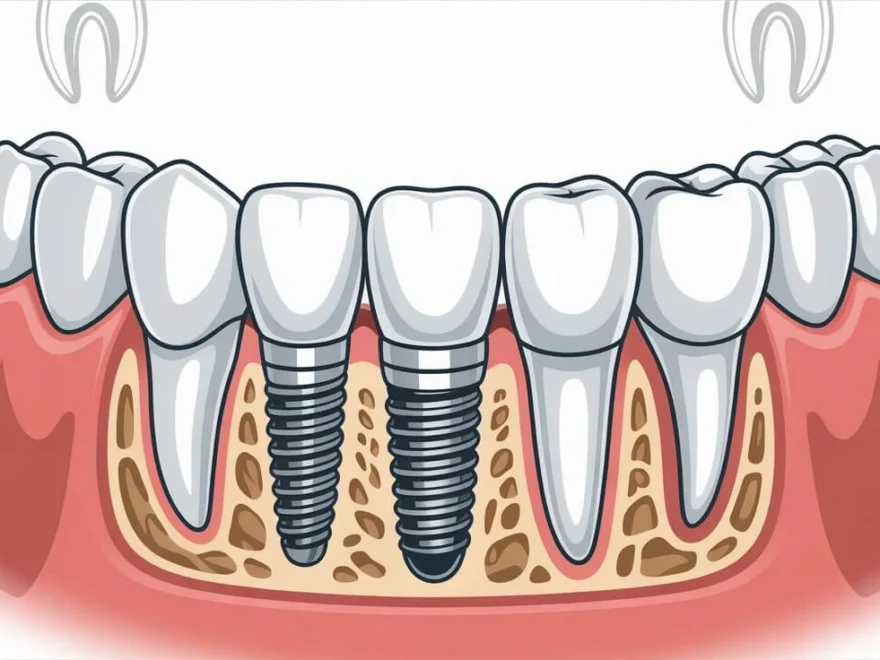If you’re researching your options for dental implants, you’ve probably come across the traditional screw-retained versions. But did you know that screwless dental implants, also known as cement-retained dental implants, offer a unique alternative that’s growing in popularity? This guide breaks down what screwless implants are, how they function, and whether they might be the right choice for your smile restoration.

Content
What Are Screwless Dental Implants?
Screwless dental implants refer to a type of implant where the crown is cemented onto the abutment instead of being secured with a screw. While traditional dental implants rely on small screws to anchor the prosthetic, screwless versions skip this step in favor of a more seamless look and feel.
These implants are still anchored into the jawbone just like screw-retained ones, but the final restoration—your visible tooth replacement—is attached using dental cement.
How Do Screwless Dental Implants Work?
The process for getting screwless dental implants is similar to other types of implants, but with a few key differences in the final stages. Instead of using a visible access hole for screws, the crown is bonded directly onto the abutment, eliminating screw visibility.
This design enhances the overall cosmetic appeal of the restoration and offers a smoother, more natural finish. Many patients are drawn to screwless implants because they combine the strength of traditional implants with a sleeker, more aesthetic final result.
Benefits of Cement‑Retained Implants
Here are the main advantages of choosing cement-retained, or screwless, dental implants:
1. Aesthetic Results
Screw holes in traditional implants can affect the appearance of front teeth. Cemented crowns eliminate that concern, making them ideal for high-visibility areas.
2. Improved Fit and Feel
Because the crown is cemented, it tends to feel more like a natural tooth. The lack of a screw access hole can also reduce the likelihood of food trapping or plaque buildup.
3. Flexibility in Placement
Screwless implants can be more forgiving in terms of angulation, offering more placement options when screw access is limited or not ideal due to bone structure or esthetic demands.
4. Reduced Risk of Loosening
Screw-retained crowns can sometimes become loose, especially over time. Screwless implants reduce this risk by eliminating the mechanical fastening component.
Step-by-Step: The Screwless Implant Procedure
The procedure for screwless implants typically includes these key stages:
Step 1: Implant Placement
A titanium implant is surgically placed into the jawbone. This forms the foundation for your new tooth. Healing usually takes several weeks to a few months.
Step 2: Healing and Osseointegration
During the healing period, your body integrates the implant with your jawbone. This process, called osseointegration, ensures long-term stability and durability.
Step 3: Abutment Connection
Once healing is complete, a custom abutment is connected to the implant. This piece will support the final crown and determine its shape and angle.
Step 4: Crown Fabrication and Cementation
A dental impression is taken to design a crown that fits perfectly. Once the crown is ready, it is permanently cemented onto the abutment.
When Is Bone Grafting Needed?
In some cases, your dentist may recommend a bone graft before placing a screwless dental implant. This is typically necessary when there’s not enough bone density in your jaw to support the implant securely.
Bone grafting helps restore volume and structure to the jawbone, ensuring your implant has a solid, long-lasting foundation. It may add a few months to the treatment timeline, but it significantly improves the success rate.
Is a Screwless Implant Right for You?
Screwless implants are often preferred in esthetic zones—like the front teeth—where appearance matters most. They’re especially useful in cases where the angle of the implant doesn’t allow for screw access without compromising the look.
However, they may not be suitable in every case. For example, if future crown removal is anticipated (e.g., in high-stress bite patterns or in bruxism patients), a screw-retained implant might offer easier maintenance.
Are Screwless Dental Implants Safe?
Yes—screwless dental implants are safe, effective, and FDA-approved when placed by a skilled dental implant specialist. As with any surgical procedure, success depends on proper case selection, technique, and follow-up care.
Maintaining good oral hygiene and regular dental checkups will help ensure your implants last for years, or even decades.
Conclusion: Are Screwless Dental Implants Right for You?
Screwless dental implants offer a modern, aesthetic, and secure solution for tooth replacement—especially in areas where appearance is a top priority. With their seamless design, natural feel, and long-term durability, they are an excellent option for many patients seeking a confident smile.
Frequently Asked Questions
Are screwless dental implants better than screw-retained ones?
Screwless implants are ideal for aesthetic zones and provide a natural look. Screw-retained implants are easier to remove and maintain, especially in molars.
How long do screwless dental implants last?
With proper care and regular checkups, screwless implants can last 15–25 years or longer.

Arlene Ross is a health blogger who enjoys writing on her website. Arlene has always had an interest in medicine, and she hopes to become a doctor one day. She loves reading about medical discoveries, especially when they are for rare conditions that don’t have much research yet. She also likes exploring the science behind different diets and nutrition programs.





